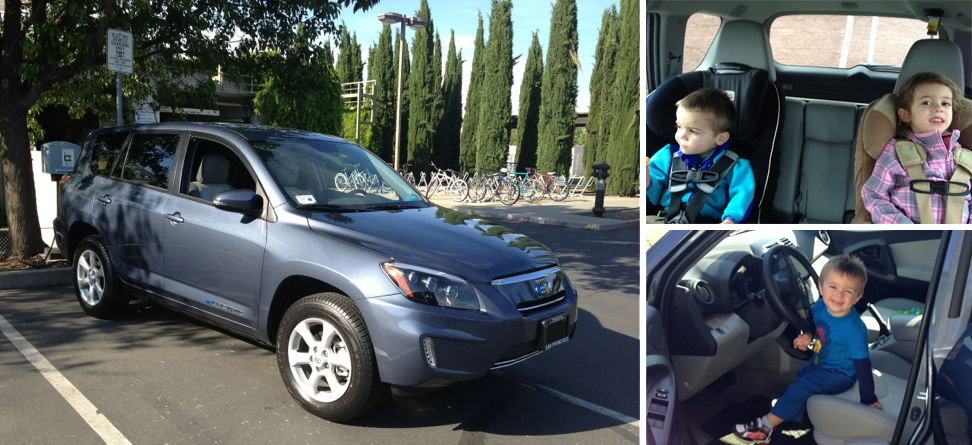This review was originally published in 2014 on the Transport Evolved website. The review was based on my experiences after driving the all-electric 2012 Rav4 EV for one year.
This review of the Rav4 EV is also intended as a primer for those who are learning about electric vehicles (EVs), those considering the switch from gasoline to electric, and those wondering if driving an EV will fit their lifestyle. The review is broken down into three installments that cover:
- 1) RAV4 EV BASICS
- 2) CHARGING
- 3) BENEFITS OF DRIVING ELECTRIC
Rav4 EV Basics
After driving gasoline and diesel powered cars, trucks, and motorcycles for over 30 years, I bought my first electric car one year ago, a 2012 Toyota Rav4 EV. The Rav4 EV is not a hybrid, it does not have a gasoline powered engine. It’s an electrified version of the Toyota Rav4 in which the gasoline motor, gas tank, muffler, and exhaust pipe have all been removed and replaced with an electric motor, battery, and a bit of electronics. If you haven’t yet driven an electric car, let me say it was a revelation for me. The quiet, smooth ride and instant torque were such a thrill that I felt like a teenager driving for the first time all over again.

I grew up in a large family that had Rambler, Rebel, and VW stations wagons. Those cars took us all over town, to school, baseball games, day trips to the Jersey Shore, and summer camping trips. I know station wagons are no longer popular, but to me the electric Rav4 EV is a modern day station wagon. It serves the same purposes for us. We drove over 13,000 miles in the Rav4 EV last year using it for our daily 50 mile round-trip commute, to take the kids to daycare, carting them around to gymnastics, for errands and shopping trips, and camping trips. Every day we strap our two kids into their car seats and off we go. The EV has never let us down.

- The 2012 Rav4 EV
The Rav4 EV is roomy and easily seats 5…. not the 9 we somehow fit in the Rebel station wagon on one occasion, but that’s a different story. The Rav’s electric drive train delivers 154 horsepower, and up to 270 ft/lb of torque. This car is a blast to drive – the instant torque and power translate into a respectable 0-60 mph time of 7.0 seconds. The interior of the Rav4 EV is basically the same as most other cars with some notable differences. For example, you press a ‘Power’ button to start the car and hear, well, nothing. EVs make less noise starting up than a desktop computer.
An 8” touch screen provides access to navigation, radio, music services, energy use monitors, and more. A useful idea but needs work. The Charge Timer app, which should allow you to plug in when you get home and start charging the car later at night when electricity rates are lower, does not work. The Charging Station app lists the nearest charging stations and guides you there via navigation – but the list and the maps are horribly outdated. Worse, they can’t be updated without spending $$$ – and the Rav4 EV has “embedded cellular technology” that should make updating map info over the air free, or at least affordable. On the plus side, the built-in cell connection gives you access to Toyota’s Safety Connect, helps you find the car and monitor battery charge level from your smartphone, and lets you turn on climate control remotely to heat or cool the cabin before you get in.
The Rav4 EV’s battery pack is located under the floor of the car so the EV version has the same interior space as the gas-powered version. With our Prius it took work fitting big box items into the car, but with the Rav4 EV we just throw it in the back. The cargo area behind the rear seats is large, and with the seats folded down it’s huge – the Rav4 EV is great for people who may need a bit more space. The swing out back door is convenient for loading items in and out, but a pickup style fold-down gate would have made hauling longer items like 8 foot lumber more practical.

- Batteries and Driving Range
Electric car batteries are classified by how many kiloWatt hours (kWh) of electricity they can store. For those unfamiliar with the term ‘kWh’ here’s a brief explanation. The 40 Watt incandescent bulb we all grew up with uses 40 Watts of electricity in one hour, or 40 Watt hours. The Rav4 EV has a 41.8 kiloWatt hour battery, meaning it can store up to 41,800 Watt hours, enough to power 1000 40 Watt bulbs.
Moving the 4000 pound Rav4 EV down the highway uses a bit more energy than a light bulb, and drivetrain efficiency is one of the factors that determines how far you can drive the car with the energy on board. Comparing gasoline and electric motors in this regard is revealing. A gallon of gas is equivalent to 33.7 kWh, so a 25 MPG gasoline powered car uses one gallon of gas, or 33.7 kWh, to travel 25 miles. That’s 0.75 miles per kWh. Electric vehicles are much more efficient. The Nissan Leaf can store 21–22 kWh in its battery, not even a gallon of gas, yet has an EPA rated range of 84 miles. That’s about 4 miles per kWh. The new BMW i3 is even more efficient, in part because of it’s lightweight carbon fiber frame. The i3 has an 18.8 kWh battery and is rated at 81 miles, or 4.3 miles per kWh, but some real world tests indicate that 5+ miles per kWh is possible.
One simple point illustrates the inefficiency of gasoline engines compared
to electric motors. To make a hybrid Toyota straps several hundred pounds of extra equipment onto a gasoline powered engine – electric motors, battery pack, and more – nearly a whole separate drive train. And what you end up with is a more efficient car that gets 50 MPG like the Prius. Why? In large part because hybrids benefit from the efficiency of electric drive. Strip the gasoline motor from these cars and what do you get? A 100+ MPG electric car like the Nissan Leaf.
The Rav4 EV is larger, heavier, and less aerodynamic than the Leaf but with a 41.8 kWh battery it can drive longer distances. The EPA rates the Rav4 EV driving range at 103 miles, which is triple the distance driven by the average American each day (US Department of Transportation). The EPA rating suggests about 2.5 miles per kWh, and that is probably what most drivers will get with the Rav4 EV, but it’s not too hard to coax more from the car, especially if you live in a mild climate. Toyota recommends charging the battery to 80% capacity for daily use (33.4 kWh, or about a gallon of gas). Our commute is 2/3 freeway and 1/3 city streets and we regularly get over 120 miles on the 80% charge. That’s driving over 120 miles on the energy stored in a gallon of gas. We’ve driven over 150 miles on a full charge, with 20 miles remaining in the battery pack – others have gone much further driving on city streets. Alternatively, you can unleash the horses and still get 80 miles to a charge – enough to cover most commuters.
One final note on range, and this is important for you parents out there: the 100+ mile range of our EV has given us the security of knowing that, even in emergencies, we’ll be OK. On occasion we’ve had to leave work, go to the daycare to pick up a sick child, take them to the doctor and then back home. This can add another 35 to 40 miles to our 50 mile commute, but the Rav4 EV meets our needs every day.
The next installment in this 3-part series will cover charging the car.
Read PART 2: CHARGING
Read PART 3: BENEFITS OF DRIVING ELECTRIC

